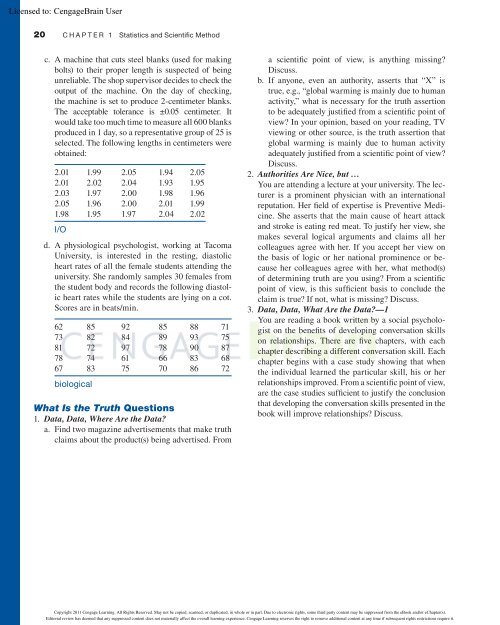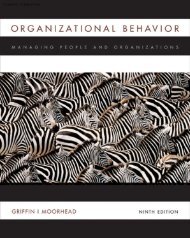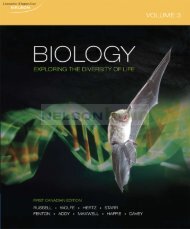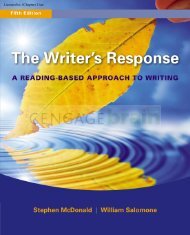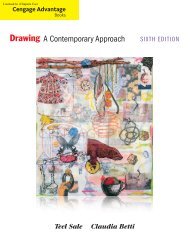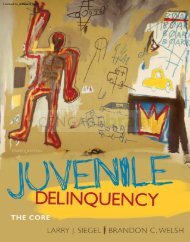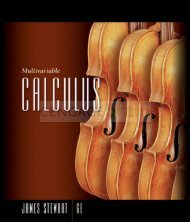Understanding Statistics in the Behavioral Sciences ... - NelsonBrain
Understanding Statistics in the Behavioral Sciences ... - NelsonBrain
Understanding Statistics in the Behavioral Sciences ... - NelsonBrain
Create successful ePaper yourself
Turn your PDF publications into a flip-book with our unique Google optimized e-Paper software.
Licensed to:<br />
20 C H A P T E R 1 <strong>Statistics</strong> and Scientifi c Method<br />
c. A mach<strong>in</strong>e that cuts steel blanks (used for mak<strong>in</strong>g<br />
bolts) to <strong>the</strong>ir proper length is suspected of be<strong>in</strong>g<br />
unreliable. The shop supervisor decides to check <strong>the</strong><br />
output of <strong>the</strong> mach<strong>in</strong>e. On <strong>the</strong> day of check<strong>in</strong>g,<br />
<strong>the</strong> mach<strong>in</strong>e is set to produce 2-centimeter blanks.<br />
The acceptable tolerance is ±0.05 centimeter. It<br />
would take too much time to measure all 600 blanks<br />
produced <strong>in</strong> 1 day, so a representative group of 25 is<br />
selected. The follow<strong>in</strong>g lengths <strong>in</strong> centimeters were<br />
obta<strong>in</strong>ed:<br />
2.01 1.99 2.05 1.94 2.05<br />
2.01 2.02 2.04 1.93 1.95<br />
2.03 1.97 2.00 1.98 1.96<br />
2.05 1.96 2.00 2.01 1.99<br />
1.98<br />
I/O<br />
1.95 1.97 2.04 2.02<br />
d. A physiological psychologist, work<strong>in</strong>g at Tacoma<br />
University, is <strong>in</strong>terested <strong>in</strong> <strong>the</strong> rest<strong>in</strong>g, diastolic<br />
heart rates of all <strong>the</strong> female students attend<strong>in</strong>g <strong>the</strong><br />
university. She randomly samples 30 females from<br />
<strong>the</strong> student body and records <strong>the</strong> follow<strong>in</strong>g diastolic<br />
heart rates while <strong>the</strong> students are ly<strong>in</strong>g on a cot.<br />
Scores are <strong>in</strong> beats/m<strong>in</strong>.<br />
62 85 92 85 88 71<br />
73 82 84 89 93 75<br />
81 72 97 78 90 87<br />
78 74 61 66 83 68<br />
67 83 75 70 86 72<br />
biological<br />
What Is <strong>the</strong> Truth Questions<br />
1. Data, Data, Where Are <strong>the</strong> Data?<br />
a. F<strong>in</strong>d two magaz<strong>in</strong>e advertisements that make truth<br />
claims about <strong>the</strong> product(s) be<strong>in</strong>g advertised. From<br />
a scientifi c po<strong>in</strong>t of view, is anyth<strong>in</strong>g miss<strong>in</strong>g?<br />
Discuss.<br />
b. If anyone, even an authority, asserts that “X” is<br />
true, e.g., “global warm<strong>in</strong>g is ma<strong>in</strong>ly due to human<br />
activity,” what is necessary for <strong>the</strong> truth assertion<br />
to be adequately justifi ed from a scientifi c po<strong>in</strong>t of<br />
view? In your op<strong>in</strong>ion, based on your read<strong>in</strong>g, TV<br />
view<strong>in</strong>g or o<strong>the</strong>r source, is <strong>the</strong> truth assertion that<br />
global warm<strong>in</strong>g is ma<strong>in</strong>ly due to human activity<br />
adequately justifi ed from a scientifi c po<strong>in</strong>t of view?<br />
Discuss.<br />
2. Authorities Are Nice, but …<br />
You are attend<strong>in</strong>g a lecture at your university. The lecturer<br />
is a prom<strong>in</strong>ent physician with an <strong>in</strong>ternational<br />
reputation. Her fi eld of expertise is Preventive Medic<strong>in</strong>e.<br />
She asserts that <strong>the</strong> ma<strong>in</strong> cause of heart attack<br />
and stroke is eat<strong>in</strong>g red meat. To justify her view, she<br />
makes several logical arguments and claims all her<br />
colleagues agree with her. If you accept her view on<br />
<strong>the</strong> basis of logic or her national prom<strong>in</strong>ence or because<br />
her colleagues agree with her, what method(s)<br />
of determ<strong>in</strong><strong>in</strong>g truth are you us<strong>in</strong>g? From a scientifi c<br />
po<strong>in</strong>t of view, is this suffi cient basis to conclude <strong>the</strong><br />
claim is true? If not, what is miss<strong>in</strong>g? Discuss.<br />
3. Data, Data, What Are <strong>the</strong> Data?—1<br />
You are read<strong>in</strong>g a book written by a social psychologist<br />
on <strong>the</strong> benefi ts of develop<strong>in</strong>g conversation skills<br />
on relationships. There are fi ve chapters, with each<br />
chapter describ<strong>in</strong>g a different conversation skill. Each<br />
chapter beg<strong>in</strong>s with a case study show<strong>in</strong>g that when<br />
<strong>the</strong> <strong>in</strong>dividual learned <strong>the</strong> particular skill, his or her<br />
relationships improved. From a scientifi c po<strong>in</strong>t of view,<br />
are <strong>the</strong> case studies suffi cient to justify <strong>the</strong> conclusion<br />
that develop<strong>in</strong>g <strong>the</strong> conversation skills presented <strong>in</strong> <strong>the</strong><br />
book will improve relationships? Discuss.<br />
Copyright 2011 Cengage Learn<strong>in</strong>g. All Rights Reserved. May not be copied, scanned, or duplicated, <strong>in</strong> whole or <strong>in</strong> part. Due to electronic rights, some third party content may be suppressed from <strong>the</strong> eBook and/or eChapter(s).<br />
Editorial review has deemed that any suppressed content does not materially affect <strong>the</strong> overall learn<strong>in</strong>g experience. Cengage Learn<strong>in</strong>g reserves <strong>the</strong> right to remove additional content at any time if subsequent rights restrictions require it.


